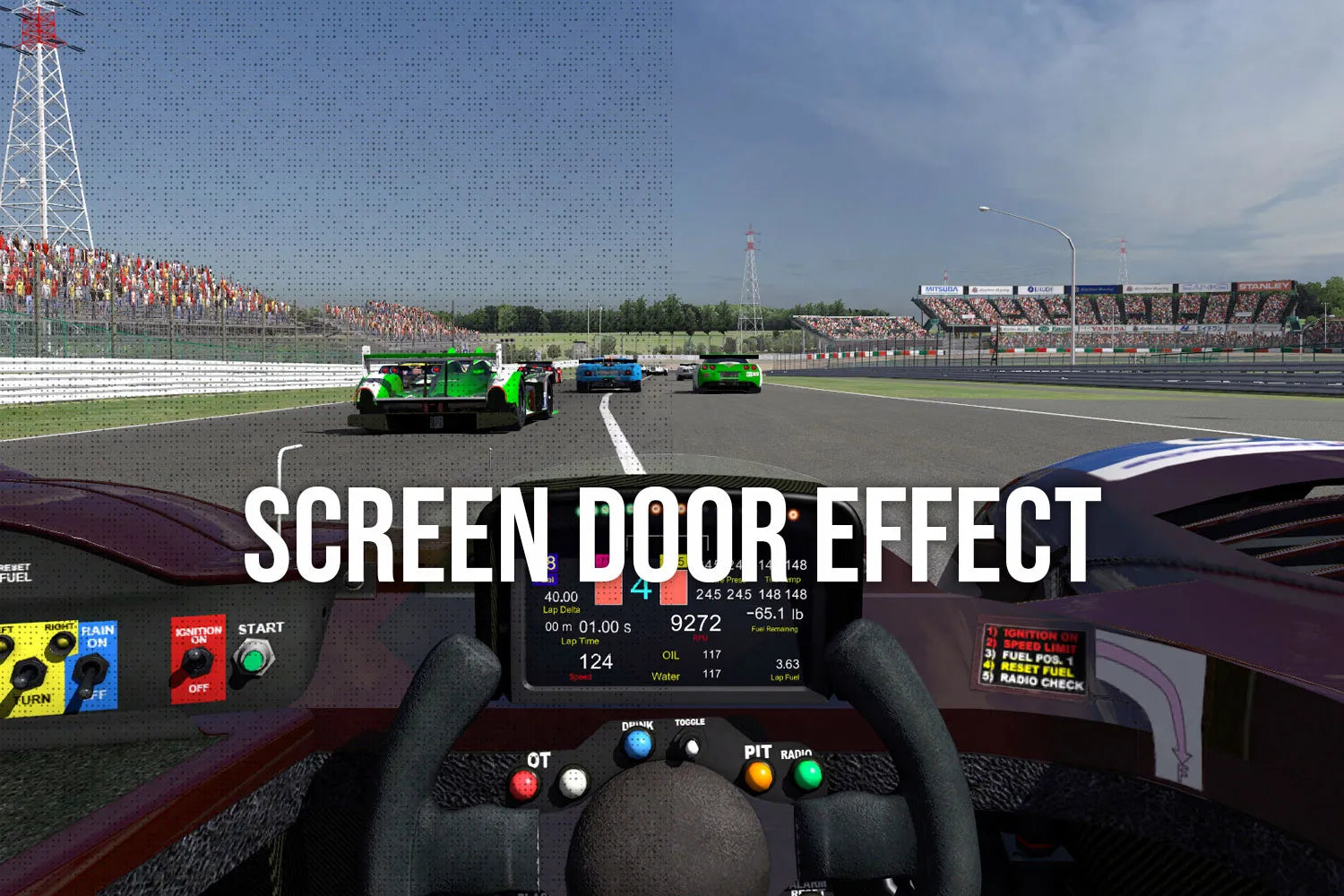The example here is very exaggerated but shows the problem:

What is the screen door effect?
The screen door effect (SDE) is a visual anomaly that appears in virtual reality (VR) displays, especially in head-mounted displays (HMDs). It is characterized by a visible grid-like pattern of fine lines or gaps between pixels on the screen, resembling a screen door.
The SDE arises because the resolution of current VR displays is not yet high enough to match the visual acuity of the human eye. Consequently, when viewed up close, the individual pixels and the spaces between them become noticeable, creating the SDE.
The SDE can be a distraction and negatively impact the perceived quality of the VR experience. However, newer VR displays with higher pixel densities have significantly reduced the SDE, such as Pimax Crystal.

Why does it happen?
To understand the screen door effect, at first, it's important to understand how displays work. Displays are made up of millions of tiny pixels, each of which can display a different color. When viewed from a distance, these pixels blend together to create a seamless image. However, when viewed up close, the gaps between the pixels become visible, creating the screen door effect.
How to reduce the screen door effect?
By using a combination of these techniques, VR manufacturers can significantly reduce the screen door effect and improve the overall visual quality of VR displays. To reduce the screen door effect, there are a few ways to mitigate the screen door effect:
Increase Display Resolution and pixel density
The most effective way to reduce the SDE is to increase the resolution of the VR display. Higher resolution means more pixels per inch, making the individual pixels less noticeable and reducing the gaps between them. Manufacturers are continuously working on developing displays with higher resolutions and pixel densities to reduce the SDE. VR headsets with higher resolutions and pixel densities have less visible pixels, which makes the SDE less noticeable. Some high-end VR headsets like the Pimax Crystal or Varjo Aero have higher resolutions and pixel densities that reduce the SDE.
Anti-Aliasing
Anti-aliasing is a technique used to smooth out jagged edges and reduce visual artifacts such as the SDE. This technique works by blending the colors of adjacent pixels to create a more natural-looking image.
Improve the lenses
The quality of the lenses in a VR headset can affect the clarity of the image. Higher-quality lenses can help reduce the SDE and improve the overall image quality.
Use Different Display Technologies
Manufacturers are developing new display technologies that use different types of sub-pixel layouts to reduce the visibility of the SDE. For example, some displays use an RGB stripe sub-pixel arrangement instead of the PenTile matrix used in many current displays.
Use Thicker Lenses
The thickness of the lenses used in VR displays can affect the visibility of the SDE. Thicker lenses can reduce the magnification of the image, making the gaps between pixels less noticeable.
Overall, the best way to reduce the screen door effect is to invest in a high-end VR headset with a high resolution, pixel density, and quality lenses. However, some of the tips mentioned above can also help reduce the SDE in more affordable VR headsets.
Pimax Crystal: unparallel VR headset conque the SDE
The Pimax Crystal has a resolution of 5760 x 2880 pixels (2880 x 2880 pixels per eye), which is higher than any other consumer VR headset. This high resolution provides a much more detailed and immersive VR experience and helps to reduce the screen door effect (SDE). The higher the resolution and pixel density of the display, the less visible the SDE becomes. In Pimax Crystal, you cannot have any screen door effect for sure. Early reviewers have confirmed this.
The high resolution of the Pimax Crystal means that individual pixels are less visible, which helps to reduce the SDE. In addition, the Pimax Crystal uses custom-designed QLED and Mini LED panels with a higher pixel density than many other VR headsets, which further reduces the visibility of the SDE and improves the overall image quality. QLED technology uses quantum dots to enhance color accuracy and brightness, and Mini LED technology uses many tiny LEDs to create more precise and localized dimming, which can help improve contrast and reduce blooming. These technologies combined with Pimax Crystal's high resolution and pixel density can help further reduce the SDE and improve the overall image quality.

Overall, the Pimax Crystal's high resolution and custom-designed QLED and Mini LED panels make it one of the best VR headsets on the market for reducing the SDE and providing a high-quality VR experience.
Summary
Thanks for your time. And if you have more questions, feel free to join us on our Discord channel. See you next time!
You may like:
Is My PC Ready For VR? | Pimax
How Much Is A VR Headset? | Pimax







